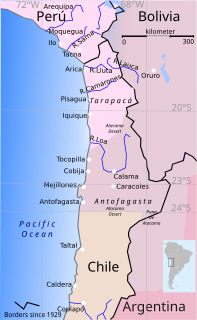
The War of the Pacific, also known as the Saltpeter War and by multiple other names, was a war between Chile and a Bolivian–Peruvian alliance from 1879 to 1884. Fought over Chilean claims on coastal Bolivian territory in the Atacama Desert, the war ended with a Chilean victory, which gained for the country a significant amount of resource-rich territory from Peru and Bolivia.
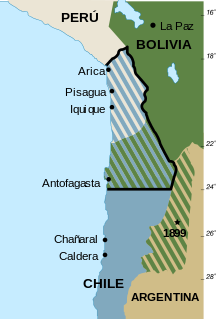
The Atacama border dispute is a dispute between Chile and Bolivia that stems from the transfer of the Bolivian Coast and the southern tip of Peru to Chile in the 19th century through the Treaty of Ancón with Peru and the Treaty of Peace and Friendship of 1904 between Chile and Bolivia after the War of the Pacific (1879–1883). The dispute is considered to be ongoing because Bolivia still claims a sovereign access to the Pacific Ocean. The conflict takes its name from the Atacama Desert on which lies the disputed territory. Due to a transfer of land to both Argentina and Chile during the Chilean annexation of the Bolivian coast in 1879, the Puna de Atacama dispute—this spin-off dispute was settled in 1899.
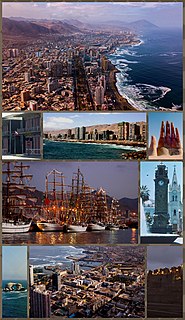
Antofagasta is a port city in northern Chile, about 1,100 kilometres (700 mi) north of Santiago. It is the capital of Antofagasta Province and Antofagasta Region. According to the 2015 census, the city has a population of 402,669.
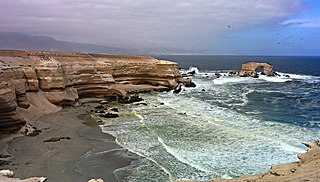
Antofagasta Province is one of three provinces in the northern Chilean region of Antofagasta (II). The capital is the port city of Antofagasta. Located within the Atacama Desert, it borders the El Loa and Tocopilla provinces to the north, the Pacific Ocean to the West and the Atacama Region to the south.

The War of the Confederation was a military confrontation waged by Chile, along with Peruvian dissidents, and the Argentine Confederation against the Peru–Bolivian Confederation between 1836 and 1839. As a result of the Salaverry-Santa Cruz War, the Peru-Bolivia Confederation was created by General Andrés de Santa Cruz, which caused a power struggle in southern South America, with Chile and the Argentine Confederation, as both distrusted this new and powerful political entity, seeing their geopolitical interests threatened. After some incidents, Chile and the Argentine Confederation declared war on the Peru-Bolivian Confederation, although both waged war separately.

The Tacna–Arica compromise or Treaty of Lima was a series of documents that settled the territorial dispute of both Tacna and Arica provinces of Peru and Chile respectively. According to the Treaty, the Tacna-Arica Territory was divided between both countries; Tacna being awarded to Peru and with Chile retaining sovereignty over Arica. Chile also agreed to pay up to 6 million dollars in compensation to Peru.

International relations between the Republic of Chile and the Argentine Republic have existed for decades. The border between Argentina and Chile is the world's third-longest international border, which is 5,300 km (3,300 mi) long and runs from north to south along the Andes mountains. Although both countries gained their independence during the South American wars of liberation, during much of the 19th and the 20th century, relations between the countries were chilled as a result of disputes over the border in Patagonia. Despite this, Chile and Argentina have never been engaged in a war with each other. In recent years, relations have improved dramatically in spite of social differences. Despite increased trade between the two countries, Argentina and Chile have followed quite different economic policies. Chile has signed free trade agreements with countries such as China, the US, Canada, South Korea, and the EU, and is an active member of the APEC, while Argentina belongs to the Mercosur regional free trade area. In April 2018, both countries suspended their membership from the UNASUR.

Chilean-Peruvian relations refers to the historical and current bilateral relationship between the adjoining South American countries of the Republic of Chile and the Republic of Peru. Peru and Chile have shared diplomatic relations since at least the time of the Inca Empire in the 15th century. Under the Viceroyalty of Peru, Chile and Peru had connections using their modern names for the first time. Chile aided in the Peruvian War of Independence by providing troops and naval support.

International relations between the Republic of Chile and the Plurinational State of Bolivia have been strained ever since independence in the early 19th century because of the Atacama border dispute. Relations soured even more after Bolivia lost its coast to Chile during the War of the Pacific and became a landlocked country. Chile and Bolivia have maintained only consular relations since 1978, when territorial negotiations failed and Bolivia decided to sever diplomatic relations with Chile. However, in spite of straining relationship, Chile and Bolivia still have economic treaties supporting tourism and cooperation; therefore, trading between two nations is not affected by the territorial dispute.

The Puna de Atacama dispute, sometimes referred to as Puna de Atacama Lawsuit, was a border dispute involving Argentina, Chile and Bolivia in the 19th century over the arid high plateau of Puna de Atacama located about 4500 meters above the sea around the current borders of the three countries.
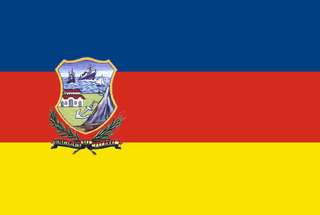
The Department of the Litoral, also known as the Atacama Department and commonly known as the Bolivian coast, was the description of the extent of the Pacific coast of the Atacama Desert included in the territory of Bolivia from its inception in 1825 until 1879, when it was lost to Chile.

The Treaty of Peace and Friendship of 1904 between Chile and Bolivia was signed in Santiago de Chile on October 20, 1904, to delineate the boundary through 96 specified points between Cerro Zapaleri and Cerro Chipe and to regulate the relations between the two countries 20 years after the end of the War of the Pacific.
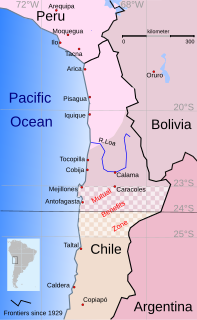
The Boundary Treaty of 1866 between Chile and Bolivia, also called the Mutual Benefits Treaty, was signed in Santiago de Chile on August 10, 1866, by the Chilean Foreign Affairs Minister Alvaro Covarrubias and the Bolivian Plenipotentiary in Santiago Juan R. Muñoz Cabrera. It drew, for the first time, the border between both countries at the 24° South parallel from the Pacific Ocean to the eastern border of Chile and defined a zone of bipartite tax collection, the "Mutual Benefits zone", and tax preferences for articles from Bolivia and Chile.
Treaty of Lima refers to a number of treaties.

Pedro José Domingo de Guerra was a Bolivian politician who served as the acting President of Bolivia in 1879 in the absence of Hilarión Daza who was fighting in the War of the Pacific between Chile, and an allied Bolivia and Peru. His grandson, Jose Gutierrez Guerra, was also president of Bolivia between 1917 and 1920.

The Treaty of Defensive Alliance was a secret defense pact between Bolivia and Peru. Signed in the Peruvian capital, Lima, on February 6, 1873, the document was composed of eleven central articles, outlining its necessity and stipulations, and one additional article that ordered the treaty to be kept secret until decided otherwise by both contracting parties. The signatory states were represented by the Peruvian Minister of Foreign Affairs, José de la Riva-Agüero y Looz Corswaren, and the Bolivian Envoy Extraordinary and Minister Plenipotentiary in Peru, Juan de la Cruz Benavente.

The Boundary Treaty of 1874 between Chile and Bolivia, also called the Treaty of Sucre, was signed in Sucre on August 6, 1874 by the Bolivian Minister of Foreign Affairs Mariano Baptista and the Chilean plenipotentiary minister Carlos Walker Martínez. It superseded the Boundary Treaty of 1866 between Chile and Bolivia and it kept the border between both countries at the 24° South parallel from the Pacific Ocean to the eastern border of Chile.

Chilean expansionism refers to the foreign policy of Chile to expand its territorial control over key strategic locations and economic resources as a means to ensure its national security and assert its power in South America. Chile's significant territorial acquisitions, which occurred mostly throughout the 19th century, paved the way for its emergence as a thalassocracy and one of the three most powerful and wealthiest states in South America during the 20th century. It also formed Chile's geopolitical and national identity as a tricontinental state and one of the countries with the longest coastlines in the world.

Obligation to Negotiate Access to the Pacific Ocean was a case at the International Court of Justice. In the case, Bolivia petitioned the Court for a writ of mandamus obligating Chile to negotiate with Bolivia to restore Bolivia's access to the Pacific Ocean, which it had lost to Chile in 1879 during the War of the Pacific. In 2018, the court rejected Bolivia's arguments, finding that Chile was under no such obligation.

The Charaña Accord, also known as the Hug of Charaña or the Act of Charaña, is the name given to an unrealized treaty that was discussed between the dictators of Bolivia and Chile, Hugo Banzer and Augusto Pinochet respectively. These discussions took place mostly on the Bolivian train station of Charaña on February 8, 1975, and included the brief reestablishment of diplomatic relations between the two nations which had been severed on 1962 because of the Atacama border dispute which was to be solved via a Chilean proposal for the exchange of territories between Bolivia and Chile, with the former receiving a corridor to the Pacific Ocean which would provide it with access to the sea and Chile receiving an equivalent amount of territory from Bolivia along its border with Chile.




















